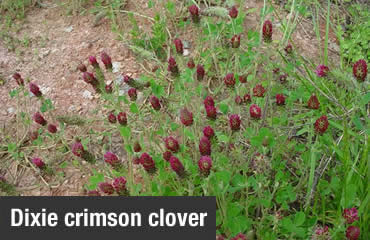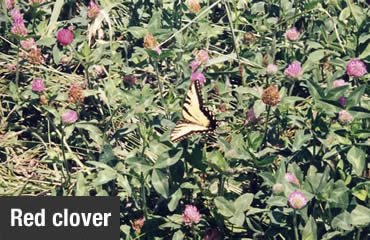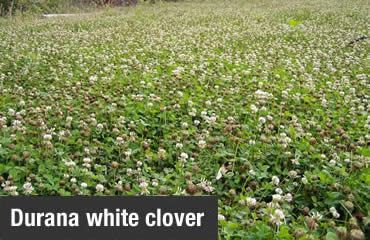Four-wheeler, treestands, camouflage, scents and rifles are all really important tools to help us harvest bucks. However, one of the most important deer management tools is often ignored, downplayed or totally left off the serious hunter's list - food plots.
Food plots not only facilitate the harvest of deer, but provide highly attractive, highly nutritious forage for your deer population virtually year-round if you have chosen the right crop and planted it correctly.
Consider clover for your high quality deer plot. There is a clover species or variety for everyone in every corner of whitetail country! Maybe you tried planting a food plot three years ago and did not get a stand. Maybe you lost a good stand in a recent drought. Unfortunately most areas of the southeast have not had adequate rainfall and lots of high quality food plots did not survive the summers over the past three years.
Maybe you are avoiding clover because it is expensive or because you are confused by the multitude of varieties available. Again, join the crowd. I have been dealing with clovers on Georgia Wildlife Management Areas (WMAs) and private lands in northeast Georgia for about 30 years, and I get confused at times, especially by new varieties, hyped advertising, and unsubstantiated testimonials.
There is another strong reason to plant clovers now more so than ever before. Clovers fix Nitrogen (N) is more expensive right now than it has ever been before due to high fuel prices. Will N ever get cheap again? Not likely. Clover fixes 50-150 pounds/acre of N every year mostly for its own growth but also provides excess N for companion grasses to use. All things considered, clover is a bargain!
Let me make it clear right now that I am a wildlife biologist, not a seed salesman.
Consequently, the rest of this article will not be devoted to selling you a specific variety of clover seed for your food plots, but rather to help you determine how to establish a successful stand of clover and what varieties have the best chance of providing you with a productive food plot that will attract, feed and grow deer. The choices can be mind-boggling: red, white, ladino, crimson, arrowleaf, or others? There are endless varieties available, but if you don't choose the right ones for your region, and if you don't take the time and effort to plant it correctly, you are setting yourself up for failure.
First, a short list of why you should plant clover for deer is in order. I've heard it said and I'm certain you have, too, "Ryegrass is all you need." "Turnips are my best choice." If you believe it's this simple, you can stop reading now and go practice on your grunt call! Otherwise, I'm here to tell you that you can do better than this if you have a hunt club or property with limited acreage for food plots, limited budget, equipment and manpower. Sound familiar?
 Consider clover for the following reasons:
Consider clover for the following reasons:
1) Lower nitrogen costs - All plants need nitrogen to grow, clover "fixes" its own from the atmosphere. The same amount fixed by clover applied to grass by commercial nitrogen fertilizer would cost an additional $25-$100 per acre per year.
2) Better forage quality of clovers when compared with grasses - Clovers have higher protein (20-30 percent), digestibility (70 percent), minerals, and vitamins.
3) Better distribution of seasonal growth by clovers can extend the grazing season as compared with grasses alone.
4) Increased forage yield per acre from grass/clover mixes or pure clover is better than grass alone.
5) Most clovers are tried and true, having been tested at university experiment stations all across the country. This is not the case with many other deer forages on the market today.
I began researching and using clovers in the late 1970's. On northeast Georgia WMAs, we had to have a productive, high quality deer forage to maximize our efforts on relatively small total acreages (<0.3% of the land area) in small fields, with limited budget, manpower and equipment. We had to get help.
No one in the deer management business really had the agronomic background during this time. Universities don't teach that in forestry schools where wildlife biologists learn the ropes. We got help from the best, Dr. Bill Sell, head of Extension Agronomy at The University of Georgia, who is now retired. Between his own Jackson County, Ga., farm and his extensive extension experience across the state, we found our expert.
What he told us, with a few minor tweaks along the way, still forms the backbone of the Northeast Georgia food plot system some 30 years later. I still seek his advice often over the phone.
Dr. Sell's formula was successful for us and can work for you. First, divide clovers into two categories, annuals are plants that die in less than a year; and perennials are plants that live for two or more years.
Chose perennial clovers when possible. If not, use reseeding annuals. Perennials work great in the Mid-South, annuals work great in the Deep South, and both work in between. Chose the varieties best suited to your soil, site, climate and limitations. Annuals do better on sandy soils while perennials may be a better choice on clay or loam. Get help from your nearest agricultural extension agent who is familiar with local conditions and varieties with a proven track record.
 Let's take some time to get detailed step-by-step procedures to establish a successful clover stand. It takes plenty of planning and good execution:
Let's take some time to get detailed step-by-step procedures to establish a successful clover stand. It takes plenty of planning and good execution:
1) Measure your field accurately to the nearest tenth of an acre. Divide the plot into rectangles and measure the length and width by pacing or using a rangefinder or GPS. Length x width = area (in square feet), then divide your total by 43,560 (sq.ft. in an acre). Eyeballing acreages will get you in trouble and waste your money because most of us over-estimate acreage and apply way too much seed.
2) Get a soil test, don't guess at it! Follow the recommendations for lime and fertilizer as indicated by the test.
3) Many of you will need two or more tons of lime per acre to raise your soil pH to 6.0 and above. Do it all at once, not in 500-pound increments, three to six months before planting, if possible. Obviously, a lime spreader truck is much cheaper and easier, if you can get it to your plot without getting stuck or busting mirrors!
4) Do a good job of ground preparation. Plow or disk repeatedly to get a weed-free, soft seedbed four to six inches deep. Then firm your seedbed with a cultipacker or drag.
5) On planting day, inoculate your clover seed with the correct inoculant as described on the package. Do not let the clover seed get too hot or too cold before planting. Remember that an inoculant is live bacteria which helps clover roots to "fix" nitrogen from the air.
6) Spread your recommended amount of fertilizer and seed. If you mix it together in a fertilizer distributor, do it on the edge of the field and don't let it sit in the hopper for long. It is best to set your spreader conservatively to go over the field at least twice to compensate for any mixing errors.
7) Cover lightly with smoothing harrows, drag or preferably a cultipacker. Do not cover clover seed more than one-fourth inch deep!
8) Pray for rain! Actually, smart farmers time their planting to plant in moist soil or precede a forecasted rain whenever possible.
9) Watch it grow!
With the clover planting techniques outlined above, you can now concentrate on which clovers to plant and where to plant them. Basically, the farther south you go and the sandier the soil, the climate is adapted to growing annual clovers and the farther north you go the climate is suited to growing perennials. There is a lot of overlap somewhere in between, depending on soils, weather, weeds and diseases. This is not a hard and fast rule, as some perennials can grow quite well in Florida or Louisiana on the right soils (clay, sandy loam or loam) and weather conditions (lack of severe drought). In north Georgia, we use both, depending on the situation and application.
All other things being equal, I would always plant a perennial clover (one which comes back from its root system for two or more years), versus an annual clover, which must reproduce from seed every year. The reasons are obvious; you don't have to plant your food plot every year, just once every two to five years. Conditions where annual clovers are the most appropriate or the only choices for you are deep, sandy soils, severe droughts, severe weed problems or low pH.
 Annual Clovers
Annual Clovers
There are two outstanding annual clovers that are tried and true in the South. These are Yuchi Arrowleaf and Dixie Reseeding Crimson. Both can be excellent reseeders under certain conditions. Yuchi Arrowleaf is the latest maturing annual clover with growth into mid-June or later under good moisture conditions. It has good reseeding potential but seedling growth is slow because of small seed size. Early planting in fall enhances stand establishment. Yuchi Arrowleaf grows best on sandy loam but will grow on any soils. Once a seed crop is produced, light disking in late August can re-establish a good stand. The leaves and stems maintain higher protein for longer periods than Crimson. Apache is a new more disease resistant variety than Yuchi.
Dixie Crimson is adapted to most well drained soils. It has excellent seedling vigor and the best early forage production of the annual clovers. Crimson is the earliest maturing clover (matures in April), which can make it very useful in a rotation with corn or grain sorghum. Unlike red or white clovers, it has no warm season value to deer. Crimson is the clover commonly seen blooming in March or April on the interstate medians in the South. On clay soil, this clover should reseed itself with mowing in August without disking for several years. On some soils, it may require a light disking in late August to reseed.
Other annual clovers useful in the South include Alyce (not to be confused with perennial Alice white), Ball, Berseem, Rose, and Subterranean. Each may have a specialized use but generally do not produce or reseed as consistently well as Crimson or Arrowleaf.
Perennial Clovers Undoubtedly, it can be a huge advantage to plant perennial clovers on hunting lands whenever possible. Labor, equipment and seed costs go way down if your food plot is productive without replanting for two or more years. Perennial clovers may require one or two summer mowings as needed to help suppress weed competition. Annual application of 200 pounds/acre of a fertilizer without nitrogen (ex. 0-20-30) in September will ensure a healthy, productive stand in year two and thereafter. There are three general categories of perennial clovers - red, white, and other.
Red clover is a biennial (two years) in the mid-South or weak perennial in the north. It acts as an annual in the Deep South. It does best on well-drained loam and clay. Spring growth begins later than white or annual clovers. Seedling vigor is better than any other clover and it is especially well suited for seeding into dormant grasses in late winter using a no-till drill or frost seeding techniques. Red clover provides more grazing than ladino clover during summer but unlike ladino, red clover will not tolerate continuous close grazing over long periods of time. Many diseases attack red clover, but disease resistant varieties are available. Check with your agricultural extension agent for varieties that are adapted to your climate and disease complex.
White clovers can be long-lived perennials and also excellent reseeders. They are very leafy plants that spread by runners (stolons) and form shallow roots at nodes. Leaves are non-hairy and usually marked with a white "V." Small or intermediate types of white clover (white Dutch, Louisiana S-1) can be expected to reseed naturally while giant or ladino types usually do not reseed well in the South.
White clovers are adapted to all regions of the eastern and mid-western U.S. but act as annuals on sandy soils in the Deep South. They are best adapted to loams, clay soils and bottomland soils. White clover is not productive on droughty soils but will survive considerable dry weather. It grows well in association with cool season perennial grasses and with dallisgrass, but generally not with bermudagrass or bahiagrass. White clover is vulnerable to a number of leaf and root diseases. Virus diseases can be the most serious problem over the long run.
Durana and Patriot are two new varieties of white clover that are proving to be the most persistent, productive varieties ever developed! They may last 5-10 years or more when well managed for weed control and fertility.
Osceola, Regal, Will, California and Advantage are some other highly productive, widely adapted ladino clovers. By comparison, white Dutch produces about one ton of forage per year versus up to five tons for the highly productive ladinos. Louisiana S-1 is a wet tolerant, intermediate non-ladino, persistent clover more productive than white Dutch but not as productive as Durana or Patriot. Durana and Patriot will also tolerate wet soils and shade very well.
Mix and Match
After describing the strong and weak points of various clovers, we need to go to where the rubber meets the road. Your best clover strategy will probably be a mixture of clovers and grains to combine the best qualities of each. In the North and mid-South, for a fall mix, many folks have had great success with a mix of Durana or Patriot white clover (five pounds/acre), Redland III or Cinnamon Plus Red clover (7 pounds/acre) and forage wheat (50-60 pounds/acre).
With acidic soil or bad weed problems (fescue, bermudagrass, bahiagrass, crabgrass, or johnsongrass), use an annual mix planted in September, February or March with red (10 pounds/acre), arrowleaf (10 pounds/acre) and cold tolerant oats like Harrison, Chapman, Arkansas 833, Buck Forage or Buck Magnet (50 pounds/acre).
Plan to mow in August and disk lightly in early September to encourage reseeding for a second year. In the Deep South, plant Crimson (10 pounds/acre), arrowleaf (10 pounds/acre) and oats (50 pounds/acre) in October. The same mowing and disking applies to encourage reseeding.
A word of caution, when at the sportsman shows or the seed store, doesn't buy the bag of premixed seed because it has a big buck picture or because it did well in Texas or New Zealand. Be wary of mixes that don't readily reveal what is in the bag.
Read the label! In most states, seed vendors are required by law to clearly identify what seed varieties and proportions are in the bag. They are required to identify noxious weeds and they must use plain English descriptions - not scientific names like Trifolium (clovers) or Brassica (turnips).
Finally, whether you mix your own or buy a mix, make sure that the percentage of grain is kept low enough to keep the grains from shading out the clovers. The same is true of acreage, if you double the seed mix on your acreage or overestimate your actual acreage, you in practice double the grain rate/acre which also will choke out the clover. The grain is there for quick forage, a nurse crop for the clover, and to produce a seed crop later on. It's there to help the clover.
Last but not least, beware of ryegrass in mixes! The great majority of you should not be planting ryegrass because you will soon live to regret it. Ryegrass is an okay deer forage plant but it does not hold a candle to clovers or small grains and it is a prolific reseeder. Mark my words, it is super aggressive and will quickly choke out your clovers. If you want a "throw and go" quick and easy "green field" that is low value to deer in the fall, go for it! Otherwise, avoid ryegrass like the plague.
Also, consider purchasing "Quality Food Plots, Your Guide to Better Deer and Better Deer Hunting," editors Kent Kammermeyer, Karl Miller and Lindsay Thomas from the Quality Deer Management Association (1-800-209-3337). It contains everything you need to know on food plots from A-Z by the top deer managers and biologists in the country!
Pennington Field Notes: Durana white clover, Patriot white clover, Red clover, Crimson clover and Arrowleaf clover are all vital seed components of Pennington Buckmasters Ultimate seed mixture.
Crimson clover and Arrowleaf clover are important seed components of Pennington Buckmasters Feeding Frenzy.
— By Kent Kammermeyer / Certified Wildlife Biologist/Consultant